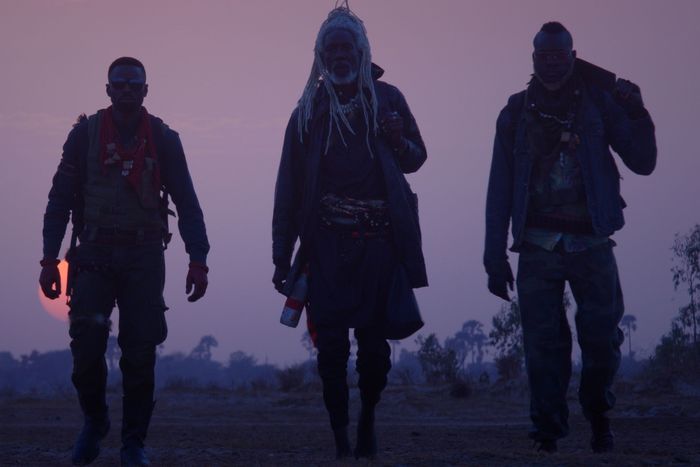
Saloum opens with a musical riff that sounds like an accelerating jet engine, a declarative African drumbeat, and a droning white-noise machine fed together through a whirring meat grinder. It’s a jarringly unnerving, unexpectedly catchy cacophony of noise that follows its own pattern — sometimes pausing and sometimes ricocheting forward — and burrows its way into your raw nerve endings, your clenched teeth, your jostled bones. That surprisingly ingratiating feeling of dissonance immediately sets the tone for writer-director Jean Luc Herbulot’s twisty fusion of heist thriller, African-Caribbean mysticism, and political horror, and it’s a pleasure to sprint alongside Saloum in an effort to keep up.
Herbulot, who is Congolese and whose Senegal-set TV series Sakho & Mangane (available on Netflix) is a kind of Law & Order meets Evil, has made in Saloum an interrogation of Heart of Darkness and an homage to various ’80s action and ’90s horror classics that remains entirely its own thing, even as the film’s plot undergoes a radical shift midway through and challenges our expectations of its protagonists’ actions. (Saloum opens in select theaters Sept. 2 and will be available for streaming on Shudder on Sept. 8.) An unseen female narrator and gunshot sounds accentuating the film’s pauses and subtitles bring to mind Quentin Tarantino; the frenetic editing style, Tony Scott; the myriad drone shots that capture Senegal’s dusty aqua waters and khaki interior, a Planet Earth documentary. But between all those allusions and nods — intended or otherwise — Saloum finds its own unsettling through line about the irreversibility of evil and the burden of infamy. Can we ever change what others have made us into, into what we yearn to be? Or is fate its own curse?
That wild soundscape from composer Reksider (doing great work alongside sound editor Ousmane Coly) starts Saloum off with an introduction to the mercenary trio Bangui Hyenas, whose “guns for hire, live by fire” ideology — as explained by that unidentified narrator, voiced by Alvina Karamoko — has made them a legend throughout Africa in 2003, when the film is set. Some say they’re cannibals, some say they’re sorcerers; the playing cards they leave behind on corpses, decorated with a hyena’s head and crossed machetes, indicate that the men relish the attention. Chaka (Yann Gael, who worked with Herbulot on Sakho & Mangane), Rafa (Roger Sallah), and Minuit (Mentor Ba) are utterly devoted to each other, and cinematographer Gregory Corandi well captures their practiced rhythms during the film’s opening attack on a compound in Guinea-Bissau: close-ups of their footwear as they move in unison up a set of stairs; a dash down a hallway as they each throw open a door and rush inside unseen rooms. The Bangui Hyenas have been doing this a long time, and the faith they have in each other has, so far, been unshakable.
Their job is to retrieve Mexican drug dealer Felix (Renaud Farah), smuggle him out of the military-coup-overtaken Guinea-Bissau, and escort him to Senegal’s capital Dakar for a hefty fee of cash and cocaine. The job seems easy enough — until their escape airplane springs a leak and they’re forced to touch down in the sparsely populated, eerily atmospheric coastal region of Sine-Saloum. The only place with supplies is a camp for tourists and vacationers that is an eight-hour walk and a boat ride away from where the Hyenas hide the plane, but what other option do they have? Baobab Camp’s proprietor Omar (Bruno Henry) and his second-in-command Salamane (Babacar Oualy) seem nice enough, and buy Chaka’s lie about the Hyenas and Felix being gold miners. And while fellow camp occupant Awa (Evelyne Ily Juhen), who is deaf, knows their secret and threatens to expose them, the Hyenas are the only ones at the establishment who also know sign language and can communicate with her. It will take just three days to secure fuel to reup the plane and resin to patch the leak, Chaka insists, and then the Hyenas and Felix will be back on their way to their payday.
But best-laid plans, and all that. Herbulot and Corandi quickly establish that Sine-Saloum is not exactly what it seems with a series of scenes that emphasize the Hyenas are being watched, and possibly hunted: shots at low angles through bushes, as if spying on Chaka and Awa; a long pan outside the camp’s bar as Rafa cleans it, with shadowy figures running alongside the exterior and hiding in corners he cannot see. Coly and Reksider add to the unease with an updated cocktail of spooky-movie noises, like whooshing winds, whispered names, clanking chains, and discordant screams. The ensemble is game, with Gael doing particularly good work as a man with a secret; a shot of his face in profile, a garish smile stretching across his face as he warns the camp, “You’ll be sick to death of us,” is an excellent moment of external interiority. The film’s only real disappointment is its visual effects, which once we see them aren’t quite as frightening as what Saloum accomplished through suggestion. Nearly every other aspect is so stylish, though — The Warriors-like fits from costumer Malick Mbengue; the claustrophobic cabins from art designer Mariam Lee Abounouom; the sarcastic humor from Sallah’s hot-headed Rafa — that some slightly generic CGI is easy to forgive.
“The Saloum preserves,” the Hyenas and Omar joke at Baobab Camp, a comment on the remoteness and isolation of this place, but Saloum puts the idea of conservation at the center of these characters’ mysterious struggle. The people who maintain the status quo are those with power, and those with power are often unwilling to share: with those who are weaker, with those who are younger, with those who are other. The propulsive energy of the film is driven both by that injustice and by the scars it leaves on places and on people, and so the horror, the horror, of Saloum is both timeless and timely.
More Movie Reviews
- Guy Ritchie Goes Brutally Posh
- Dune: Part Two Is Zendaya’s Movie
- Drive-Away Dolls Is Just Fizzy Enough





